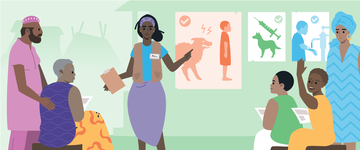Community outreach
Community involvement is key to prevent and treat Rabies cases
As community health workers, we have a unique opportunity to educate and empower our communities about rabies prevention and control. Here are some key points to cover in your engagement with the community:
- Rabies is a deadly disease transmitted to humans by infected animals, most commonly dogs.
- Children are particularly vulnerable due to their frequent interactions with dogs.
- Rabies cannot be treated once symptoms appear, but timely intervention can prevent the disease from developing.
- If someone is bitten, scratched, or licked on broken skin by a potentially rabid animal, immediate and correct treatment is crucial. This period before symptoms appear is vital for stopping the disease.
- Rabies spreads through the saliva of infected animals, typically via bites, scratches, or licks on broken skin.
We should also encourage parents, caregivers, and dog owners to:
- Vaccinate dogs early while they are puppies and ensure their vaccines are up to date. This is the most effective way to prevent rabies.
- Teach patients to recognize and report a dog with rabies to avoid them and help stop the spread of the disease.
- Teach patients to be kind and cautious around dogs to ensure they are treated with care and prevent attacks by rabid animals.
- Act quickly if a child is bitten, scratched, or licked by a dog. Wash the wound thoroughly with soap and water for at least 15 minutes, then go to the nearest healthcare facility for urgent treatment.
Click on each button to learn more about what we should recommend to patients, parents, and caregivers 🔘
Average Rating: ☆ ☆ ☆ ☆ ☆ (0 reviews)


